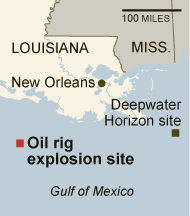
La página que intenta visitar sólo está disponible en inglés. ¡Disculpa!
The page you are about to visit is currently only available in English. Sorry!

[Updated 9/2/2010] Four months after the Deepwater Horizon exploded and sank, an oil production platform in the Gulf of Mexico exploded this morning and is burning. All 13 workers are accounted for; one is injured.
 While news reports early in the day indicated that an oil sheen had been spotted near the accident, this evening, the Coast Guard said that its responders in boats and aircraft saw no evidence of a leak from at the site of the Mariner Energy platform, called Vermillion Block 380, located about 90 miles south of the Louisiana coast. The fire was contained but not put out as of the afternoon.
While news reports early in the day indicated that an oil sheen had been spotted near the accident, this evening, the Coast Guard said that its responders in boats and aircraft saw no evidence of a leak from at the site of the Mariner Energy platform, called Vermillion Block 380, located about 90 miles south of the Louisiana coast. The fire was contained but not put out as of the afternoon.
No one knows yet what caused the explosion, and it's unclear whether the platform is in danger of collapsing. The structure is in relatively shallow waters (340 feet deep), and wasn't affected by the Obama administration's ban on deepwater drilling in response to the BP disaster (the moratorium applies to drilling in waters deeper than 500 feet).
The Financial Times reports that Mariner employees were among the 5,000 oil industry workers protesting the moratorium in Houston yesterday (ouch, tough timing):
| “I have been in the oil and gas industry for 40 years, and this administration is trying to break us,’’ said Barbara Dianne Hagood, senior landman for Mariner Energy, a small company. “The moratorium they imposed is going to be a financial disaster for the gulf coast, gulf coast employees and gulf coast residents.’’ |
Apparently, the Mariner platform had been undergoing maintenance work and wasn't producing oil or gas at the time of the accident. During the final week of August it had produced some 9.2 million cubic feet of natural gas per day and 1,400 barrels of oil and condensate, The New York Times reports.
More from the Times:
| The platform has been the site of at least four accidents — two of them fires — since 2000, according to federal records. One fire that resulted in an injury was reported on the rig in 2002. In June 2007, a welder using a torch to cut a pipe was injured when oily sand in the pipe flared up, reddening his face, neck and ears.
In May 2008, a crew member was seriously hurt when a large chain came loose and struck him in the face. And a pipeline leak was reported in 2000, when the platform was operated by a different company. |
It's unfortunate, but not surprising that there's been another explosion, given the number of platforms in the Gulf.
Mike Tidwell writes in his feature "Windfall" in Audubon's September-October issue:
|
Nearly five months after the Deepwater Horizon oil rig exploded in April, many Americans still lack a sense of scale when it comes to offshore drilling in the Gulf of Mexico. Quick: How many oil and gas structures are there in the Gulf today? A few dozen? A few hundred? Answer: Roughly 4,000. And what does that look like? Well, if you lined them up end to end, the platforms would stretch from Washington, D.C., to Philadelphia, rising more than 10 stories above the ground and with a width nearly that of a modern aircraft carrier. It takes about 85,000 full-time workers just to maintain this offshore oil field, more than four times the number of workers in the U.S. space program. What’s more, thanks to something called “directional drilling,” those platforms actually tap into 5,969 active wells. That means there are nearly 6,000 literal punctures in the Gulf floor where oil or gas is coming up. Deepwater Horizon’s collapse ruptured just one of those wells. And each well, of course, has a blowout prevention device of some kind, all of them carrying the now-dubious promise of permanent safety. |
Today's unfortunate accident is a reminder that we can't forget about the BP oil spill now that crude is no longer leaking and oil is evaporating. We have to learn from it.
(For more on the long-term affects of the BP oil spill, check out our special report on the Gulf oil spill.)